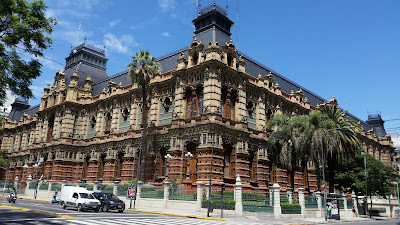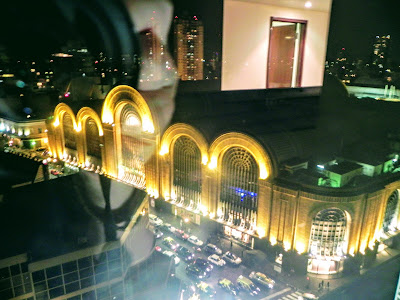By Tuesday morning on February 11th; Paul, Juana, and I said goodbye to Leo at the airport as he returned to Chicago. Then the three of us caught our later flight from the Lima airport to Buenos Aires. We arrived, got settled in our Airbnb that evening with some mishap; but the flight went quickly and smoothly, and we arrived thirty minutes earlier than our scheduled arrival time.
The Airbnb hostess, Sofie, was wonderful, and arranged for us to have a currency changer arrive the next morning, so we could exchange dollars for Argentinian pesos. Since I am a late riser, Paul was in charge of the financial wheeling and dealing. He did exceptionally well in procuring for us the best rates. Pesos were exchanging on the market at 61-62 pesos per dollar, and Paul got us 75 pesos for a dollar, due to a Cuencano friend who told us to bring lots of fresh one hundred dollar bills to exchange, and we will get better rates than just the currently listed exchange rate. Restaurants in Buenos Aires, when using credit cards, can also give very bad exchange rates, so we paid in cash in pesos whenever we ate out.
Below, Paul, looks like he is enjoying himself way too much, playing with all the monopoly-looking bills. "I'm rich! I'm rich!"
Below, Paul and Juana divvying up the pesos, including my share when I finally rose from my slumber.
The thing is, we have this gigantic wad of twenty peso bills to pull out wherever each of us went to pay for anything, and it might not amount to more than sixty to eighty dollars. I would feel like I had a wad of thousands of dollars, and wondered when I was going to get robbed. I brought some two peso bills I had left over from my visit to Buenos Aires in April of 2014. No one would take them. The inflation rate had been so out of control that two peso bills are no longer in circulation.
BUENOS AIRES -- BACKGROUND
Buenos Aires has a population of approximately 2,900,000 in the city proper, which is about two hundred thousand more people than Chicago, the third largest city in the United States. Two things about the people, which after spending only a short time in B.A., became noticeable: First, how European the people look compared to other South American countries; and second, like Europe and the United States, how much older the people as a whole are compared to almost anywhere else in South America. Where Lima was teeming with children, Buenos Aires is teaming with a high proportion of senior citizens, and children are not prevalent on the streets and in the parks.
Buenos Aires has a fascinating history, it is by far the most European city both culturally and ethnically in South America. The same holds true for all of Argentina and its neighbor, Uruguay. Both countries are about 88% European stock, mainly Spaniards and Italians, and about eight percent German.
During the Napoleonic Period in France in the early 1800's, Argentina gained its independence from Spain. Argentina grew prosperous after independence. It had seen itself as an outpost of Europe during its colonial days. Now in its affluence and independence, as Buenos Aires became the new nation's capital; the city began to grow in stature, while consolidating control over less populated areas until Argentina reached its currently set boundaries. The Portenos were disappointed that they failed in their attempts to encapsulate Uruguay into the Argentinian fold as well.
The people of B.A. are known to this day as Portenos, because of the port in Buenos Aries. The Portenos chose not to imitate the Spaniards, even though most Portenos were of Spanish blood in the mid-1800's. They perceived their former colonial masters as oppressive and exploitative of their former colony's wealth. Napoleon dominated the European landscape in the early 1800's. By the mid-century, their was a complete rebuilding of Paris, and the French were viewed not only by the Portenos, but much of Europe as the most culturally sophisticated nation of the day.
Therefore, B.A. attempted to imitate many features of Paris. To this day one can visit the neighborhoods and see quite a few French Empire architectural styles, also referred to as the Republic style, despite the fact that many such buildings were razed in the 1960's and 1970's.
The Beau Arts style in BA is represented by some architectural gems, which was a style created in Paris, and emanated in imitation throughout the world; Beaux Arts is a late and eclectic form of Neoclassicism. It combines classical architectural styles from ancient Greek and Roman designs with Renaissance ideas.
Would you believe, that the building in the photos below is the Water Company Palace? It was inaugurated in 1894, and is still used today to pump municipal water. It stretches the sense of Beaux Art design in luscious colors. There are figures that look like identical, little bearded men near the top of the pillars, which struck me as comical. Add the palm trees surrounding the "palace", and it hardly represents a Beaux Art design that would be found in Paris, which gives the design its own distinctive Porteno style. This building was only down the street about three blocks from our first Airbnb where we stayed in BA.
Other European designs found in Buenos Aries are Neo-Classical styles (photo below) borrowed from ancient Greece and Rome, which were popular styles in the world in the late 1800's and early 1900's,
and the Art Deco styles of the 1920's and 30's, as exemplified in the photo of the building below, which is located on Avenida Corrientes in the Ambasto area of BA.
This building began the twentieth century as a fruit, vegetable, and meat mercado. Later, the interior was transformed into a modern shopping mall: which includes glitzy stores; a very large food court that spills down into a sub level of more restaurants, pastry and coffee shoppes; and yes, it has cinemas, and an amusement park with some major rides as well as kid's rides, and an arcade all on the top floor. It is best to visit the mall at night, when all of the carnival rides and the entire food court is lit up.
There is no doubt that Buenos Aires is the cultural capital of South America. It is also referred to as the Paris of South America. Just as Beirut, Lebanon is called the Paris of the Middle East. Both borrowed heavily from Parisian culture. While some Parisians who visited Buenos Aires saw it as a poor imitation of the city on the River Seine, the elites of BA felt enriched by their imitation and the use of their wealth in such pursuits.
There are critics who believe that the Portenos by such heavy imitation of Parisian culture, stunted their own cultural evolution and development over time, placing Portenos in a time-warp. I imagine that there is a kernel of truth to such criticism, but most likely an overstatement as well. There may also be a nostalgia for a past by Portenos for the days when Argentina was the wealthiest nation in South America before the economic collapse, especially of the past decade. However, Buenos Aires never became as rich and as large as New York City, whom they increasingly imitated in art and cinema during the twentieth century, and therefore never became the trend center of fashion and arts as N.Y.C. Most people, however, never realize that Argentina began the twentieth century as one of the most wealthiest countries in the world. It was wealthier than France or Germany, twice as wealthy as Spain, and equal to wealth with Canada. The once wealthiest nation in South America, Argentina has slipped to third behind Chile and then slightly behind Uruguay.
On the other hand, there are generally seeds of new beginnings in many cultures when they appear stagnant. For example, more newer contemporary architectural styles are appearing in the central district of B.A. There is also an area on the edge of B.A., which has been dominated by a new wave of contemporary architects and architectural styles. Nonetheless, it is also difficult in these days to be cutting edge culturally when the nation is faced with endless economic problems and high inflation.
COLON OPERA HOUSE
With the history lesson out of the way, there is so much to do in Buenos Aires, that without some understanding of the history and culture, so much of the flavor of the city is lost. Nothing exemplified the wealth and desire to be a cultural capital for Portenos more than the Teatro Colon. which also happens to be designed in a Beaux Art style.
Below is a photo of the entrance to the Colon Opera House, which opened its doors for the first time on May 25, 1908.
An interior view of the Opera House windows


The lobby is very attractive, and the balconies above it are outlined with the sculptured busts of the great composers of European concert music and opera.
Above is a bust of Mozart, and below is a bust of Wagner.
The photos below are of the ceilings in various hallways around the opera auditorium itself.
In the photos below; the elegant ceiling, chandeliers, and the room itself is reminiscent of being in the Palace of Versailles.
I first visited the Colon in April of 2014. This second visit also involved a one hour guided tour.
I would highly recommend to anyone visiting the Colon for the first time to definitely take the guided tour. It is fascinating, and so much is missed, if one just walks through the Colon on their own. During my first visit, our tour was very fortunate as were able to sit for about fifteen minutes and watch the opera team practice for Rossini's, Barber of Seville, which unfortunately, was opening a week after I left Buenos Aires.
The Opera House Auditorium seats an audience of 2,400. According to our guide, the auditorium is recognized for having the best acoustics of opera halls and concert halls in the world. It is a favorite of both opera singers and orchestra leaders. Our guide stated, that when Placido Domingo was to perform, he feared that any mistake would be detected by the perfection of sound in the auditorium. He was brought to tears by his performance in the Colon for its purity of sound.
I refer to Teatro Colon as an opera house, which is its main venue, but many concerts and other types of music venues are offered throughout the year. Definitely place Teatro Colon at the top of your list as one of the understanding gems to visit when visiting Buenos Aries. It is even more spectacular if one hasn't toured Europe at this juncture in one's travels.



























This comment has been removed by a blog administrator.
ReplyDeleteThis comment has been removed by a blog administrator.
ReplyDelete